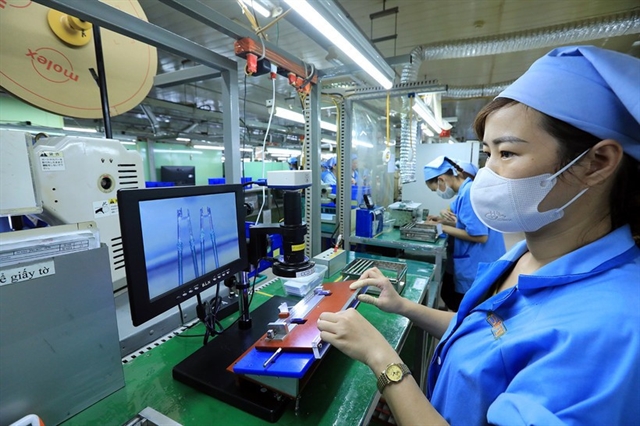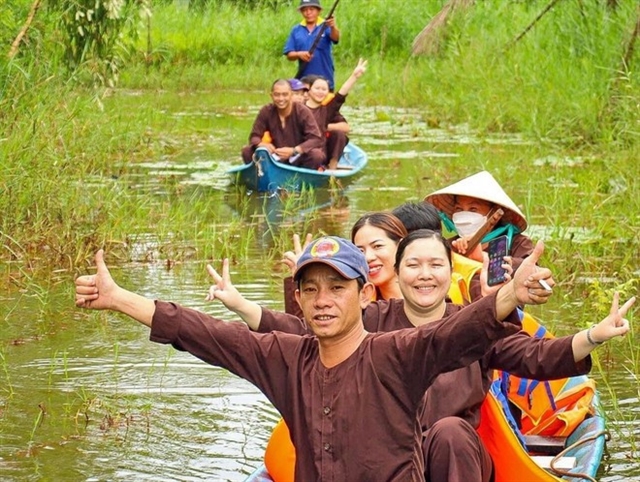 Life & Style
Life & Style


|
| Tourists visit an eco-tourism site in the U Minh Hạ forest in Cà Mau Province. — Photo VNA/VNS |
HCM City — Localities in the Mekong Delta are striving to improve the quality of cultural and tourism products through standout events, aiming to attract visitors in the remaining months of the year, contributing to Việt Nam’s goal of welcoming 25 million international arrivals and 150 million domestic tourists in 2025.
Following administrative boundary adjustments, the regional localities with great tourism potential have quickly reassessed their strengths and cultural identities, planning a series of cultural, art, sports, and commercial events to showcase their potential, promote their image, attract visitors, and draw investors to explore tourism and business opportunities.
The People's Committee of Cà Mau province has announced that the Cà Mau Crab Festival will be held from November 16 to 22 at various locations throughout the province. The festival will showcase a variety of events and activities that highlight the cultural identity of this southernmost region. It will provide an opportunity for tourists, residents, and businesses to explore the culture, people, and landscape of Cà Mau.
The festival will also include the signing of cooperation agreements and trade exchanges for seafood and other local specialties, with a focus on Cà Mau crab as a key product.
The Cần Thơ River Culture Festival 2025 is set to take place in Cần Thơ City from December 27, 2025, to January 1, 2026. This festival is a key cultural and tourism event for the city and will feature a variety of activities that celebrate riverine and orchard culture, showcase ecological tourism products, present art performances, and highlight local culinary specialties. The festival aims to promote the unique river culture of the Mekong Delta, particularly that of Cần Thơ City, while also encouraging the sustainable use of river-based tourism resources.
The festival is expected to support the development of urban tour routes, enhance river tourism connections between HCM City, Cần Thơ, and other Mekong Delta provinces, and expand cross-border river tourism circuits linking countries along the Mekong River.
Meanwhile, the Đông Hòa Hiệp Ancient Village Culture and Tourism Festival is set to take place from December 3 to 7 in Cái Bè Commune, Đồng Tháp Province, highlighting the village’s heritage, handicrafts, and eco-tourism linked to agricultural production.
Additionally, the Sa Đéc Flower and Ornamental Plant Festival 2025 is scheduled for December 27 to January 4 in Sa Đéc ward of Đồng Tháp Province, celebrating the village’s renowned floriculture, known as the “flower capital” of the Mekong Delta region.
The Mekong Delta localities not only organise standout events but also design and connect diverse itineraries, combining cultural and historical tours with immersive local experiences across the Delta, HCM City, and the Southeastern region, attracting both domestic and international visitors.
According to a representative from HCM City’s Department of Tourism, to enhance connectivity, the agency launched a new tour, starting from the southern metropolis, passing through Đồng Tháp and An Giang provinces, with many historical and cultural sites, border landmarks, and exploring trade activities at the Việt Nam - Cambodia border gates.
Meanwhile, Director of the Department of Culture, Sports and Tourism of Vĩnh Long Province Dương Hoàng Sum said that Vĩnh Long is offering visitors multiple experiential routes under the motto “One route, three destinations,” highlighting the distinctive tourism resources of the three former provinces of Trà Vinh, Bến Tre, and Vĩnh Long before their mergers.
According to Nguyễn Văn Bảy, Director of the Department of Culture, Sports and Tourism of Cần Thơ City, the locality is stepping up promotion and connections with HCM City and other localities in the region, as well as key tourist destinations nationwide, including Hà Nội, the Northwest, the Northeast, and the Central Highlands. Visitors are offered diverse experiences, from river ecotourism and cultural tours to historical sites and craft villages, to educational tourism and MICE tourism. — VNA/VNS